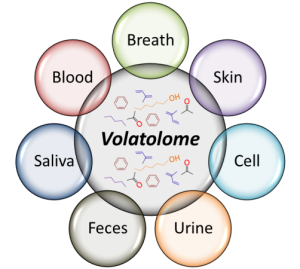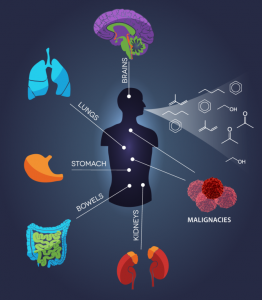Volatolomics, the scientific study of chemical processes involving profiles of highly- and semi- volatile organic compounds (VOCs) opens a new frontier in meeting these challenges. Disease-specific VOCs are produced mainly through changes in specific biochemical pathways in the body. Following their production, VOCs are emitted and are found in bodily fluids, including in infected cells and/or their microenvironment, blood, breath, skin, urine, feces and/or saliva.
The LNBD group conducts studies in different aspects of volatolomics, focusing on breath and skin samples. Exhaled breath and skin headspace can be obtained non-invasively, are suitable for high compliance, and provide a matrix of relatively low complexity. In this effort, the lab is developing and characterizing artificially intelligent arrays of solid-state and flexible sensors for the detection and classification of various diseases in a non-invasive, fast and inexpensive manner, with low energy consumption. In addition to conducting R&D on sensing devices, lab researchers examine the developed devices via actual clinical trials on diverse diseases, malignant, neurodegenerative or infectious. These trials involve human volunteers together with in-vitro and in-vivo studies using different cell lines and animal models. In parallel, the lab assesses theoretical pathways and transport of different VOCs/chemicals from the internal, toward the external, side of the body.
LNBD researchers study potential biomarkers for different diseases and conditions. They attempt to increase the selectivity of nanomaterial-based sensors towards these biomarkers. Volatile biomarkers are studied through various mass spectrometry techniques.



